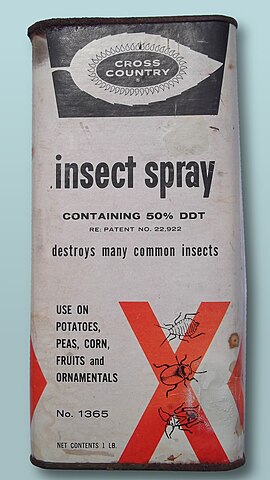
What is DDT? It stands for dichloro-diphenyl-trichloroethane and was the first synthetic pesticide. It was banned in 1972.
DDT didn’t start being used in large quantities until after the Second World War, but it had been discovered quite a while earlier. Othmar Zeidler, an Austrian chemist, first synthesized DDT in 1874. Nobody realized that it could be used as an insecticide until 1939, when a Swiss scientist called Paul Hermann Müller realized. He ended up winning a Nobel Prize in 1948 for this discovery. The Nobel Prize committee said that he had saved hundreds of thousands, if not millions of lives, with his discovery. That is something that cannot be argued with.
Before the discovery of DDT, there were not many successful pesticides. The struggle with pests had been ongoing ever since humans domesticated crops and started to farm them. There is evidence that the Sumerians used sulfur as a way to control insects about 4,500 years ago. People also used heavy metals, such as arsenic, and salt. After the Industrial Revolution, the fields of science began to grow and people learned how to extract chemicals from plants. Scientists looked at plants that could naturally repel pests and extracted the chemicals from them. Nicotine is a good example. These pesticides were fairly expensive to produce and they didn’t work on all insects.
Müller worked for a company called J. R. Geigy AG Basel when he made his discovery. They put him in charge of trying to find a successful insecticide that could kill insects across the board. He accepted the job in 1935 and began looking for a chemical that would do the trick. He says that he tried 349 different chemicals before he found the one that worked, and that one was DDT. He placed a fly in a cage with the compound and within minutes the fly had died. He had discovered the pesticide he was looking for.
The way DDT killed that fly is the reason why it was such a successful pesticide. When the DDT came into contact with the fly, it was absorbed into the fly’s body. Once there, it gets into the fly’s nervous system and makes the neurons fire, in a similar way to an epileptic seizure. This makes the fly’s muscles spasm, and, over the course of a few hours, it dies. Like an epileptic seizure that never stops. It turned out that DDT worked on most insects and was a very effective pesticide.
DDT underwent many tests, but it was in World War 2 that it was used in large quantities. The first recorded use of it was to end a typhus epidemic in Naples, Italy. Typhus is spread by bacteria that live on fleas and lice. The people of the town were sprayed with a 10% solution of DDT and all of the lice died. The typhus epidemic was ended in a few weeks. It appeared that they had found the perfect pesticide that was lethal to insects and harmless to people.
After the war, DDT was used everywhere for several years. It was used to end the malaria epidemics that had plagued Europe for so long and is the reason why these days malaria is only found in poor African countries. It was used on crops and everywhere that insects might be a problem. It was especially effective because it didn’t wash off crops easily and stayed for a long time. One spraying with DDT would protect the crops for several weeks and was still lethal to insects. It was easy to produce in vast quantities and it was very cheap. It was perfect. And it worked mightily well, until it was banned by most countries.
The first country to ban it was Hungary in 1968 and by 2004, it had been banned by 170 countries. It is still used in North Korea, India, and several other countries. The WHO is trying to get it completely banned there as well, but it is still effective and cheaper than any alternative. So, why was it banned if it is so good?
It wasn’t banned because of its health risks to humans. It isn’t great for people, but it isn’t as bad as many other chemicals. Long term experiments have shown that over a long period of exposure, it could harm reproductive health, and it could possibly cause tumors, although there is no definite proof. There is one problem in that DDT can build up in fatty tissue. It is very soluble in fat and can stay in the body for long periods of time inside fat cells. But that wasn’t really the reason why DDT was banned. It was banned because of four main reasons.
Firstly, insects started to develop resistance to DDT. As bacteria do with antibiotics, some insects developed the ability to break DDT down into a less harmful compound called DDA. They could then expel this without it doing them any harm. The second reason is DDT ends up in the soil where it builds up and stays there for a very long time. DDT is still being found in the soil, decades after it was last used. Thirdly, it was too good at killing insects and it killed not only the pests, but all other insects as well. It was indiscriminate and if we kill all of the bees and the butterflies, we end up with no pollination and no fruit or flowers. And fourthly, it didn’t kill people, but it did kill lots of the animals. It was lethal to fish, frogs, small birds, lizards, and small mammals. There are other reasons as well, but the environmental dangers were too great to continue using DDT. Since then, other pesticides have been invented, but there is no such thing as a “perfect” pesticide yet. And this is what I learned today.
Image By Xanthis – Photograph of an old DDT powder container, CC0, https://commons.wikimedia.org/w/index.php?curid=133803086
Sources
https://en.wikipedia.org/wiki/Paul_Hermann_M%C3%BCller
https://en.wikipedia.org/wiki/DDT
https://www.epa.gov/ingredients-used-pesticide-products/ddt-brief-history-and-status
https://www.ncbi.nlm.nih.gov/pmc/articles/PMC7581488
http://npic.orst.edu/factsheets/archive/ddttech.pdf
https://reviews.history.ac.uk/review/1445
http://npic.orst.edu/factsheets/bb-ddt.html
https://iubmb.onlinelibrary.wiley.com/doi/pdf/10.1080/15216540701352042
